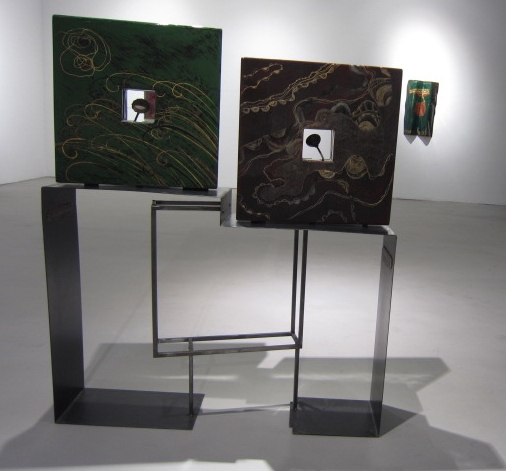My First Experience With a Lacquer Artist
Time:October 19, 2011 Author: Editor: Source:
Photo:
The inauguration of The Chemance of Three Artists 2011 International Lacquer Art Exhibition was held on Sep.25th. Three contemporary artists in the lacquer field will exhibit their lacquer works during the entire exhibition from Sep.25thto Oct. 28th. They are Nagatoshi Onishi from Japan, Isabelle Emmerique from Franceand Li Lun from the Guangzhou Academy of Fine Arts. I worked as a volunteer translator for Isabelle, which made it much easy for me to get first hand information. It was a really good opportunity for someone who never touched upon art to gain a better understanding of art through those artists, especially Isabelle's lacquer works and it's reflection on the current situation of Chinese lacquer on the world arena.

Isabelle's lacquer work- La Porte
Lacquer is an art form that originated in China. China is rich in the trees that provide the material. This art form now flourishes in Japanand Europe but has become scarce in China. This is why more exhibitions and symposiums about lacquer have emerged in China recently. However, the ability to transform traditional artwork into modern ones is a question that constantly perplexes us all. As we know, Chinais an ancient country with a rich history and sparkling tradition. Tradition is good, but creation is much more than that. .

The bell on the door
Unlike China, Francedoesn't have the lacquer tree, which is a limitation for them to make lacquer. However, the spirit of creativity and innovation in French people's blood will never let those external obstacles hinder their zest for pursuing art. Three hundred years ago, French invented varnish, an equivalent to Qi in Asia. French people created their lacquer works by imitating eastern pieces of art. However, they didn't stay at the primary imitation step. Isabelle, during her interview with the Southern Metropolis Daily, exerted much emphasis on the French spirit in her works while still maintaining a strong sense of oriental flavor. She gained the inspiration for her works ''La Porte''during her travels in Burma. That's why we see the oriental waves, patterns and bells inserted in her works. Every piece of her work contains two parts, like a double doorway does. Isabelle regards this as a symbol of cultural integration. Each part of the door represents one culture, and their juxtaposition simply signals that when two different cultures encounter each other, they should listen to each other and try to communicate.Aside from the oriental flavor, the techniques and the typical French color are totally western. Thus Isabelle's works may be considered as a perfect combination of western and eastern culture.
When I conversed with Isabelle, I could feel her deep devotion to lacquer and her lifelong pursuit for perfection in art. She started her career from a magic experience with the smell of Qi. Then she became totally infatuated with lacquer. It's like a true lover. "Everyday when you open the door, you smell the flavor, and you cannot walk away from it", she said with a pondering smile.
This stands original

